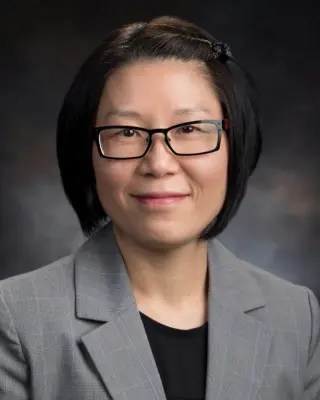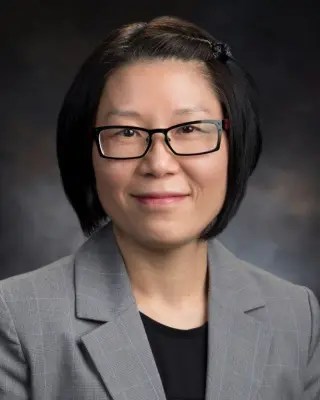
Dr. Nipa Phojanamongkolkij does not always do things the traditional way. As a systems engineer (SE) at Langley Research Center working closely with the Aeronautics Research Mission Directorate, Nipa pushes boundaries and draws connections where few others would think to look. When she envisioned a way to use ChatGPT to help SE teams working on the Advanced Air Mobility Mission, she presented her initial idea to her team wondering, “Is this crazy?” Her idea evolved into a successful prototype, which is now used for air traffic management in the Airspace Operations and Safety Program. She has also leveraged natural language programming and NASA’s database of lessons learned to create a bot for flagging potential risks and mitigations in real time. Nipa’s journey in becoming the digital transformer she is today involves her ability to combine engineering principles and business outcomes with creative, human-centered approaches.
Nipa received an MS and PhD in industrial and systems engineering from Arizona State University after moving to the United States from Bangkok, Thailand, where she received her BS degree in electronics engineering. She joined NASA 15 years ago after honing her data analysis and process improvement skills in the business sector at Pepsi Corporation. Her previous experience molded her focus on demonstrating benefit and return on investment. In addition to a business-oriented mindset, Nipa credits much of her success at NASA to her abilities as an active listener, which helps her understand customer needs and address paint points.
One cross-cutting challenge Nipa noticed within the agency’s approach to SE was the issue of silos, particularly in handling requirements and research data. Many engineers stored information in documents on individual computers or SharePoint folders, making it difficult to share data and draw connections across missions, directorates, and centers. As a systems engineer, Nipa and her team work to pull these disparate elements into a connected digital format using methodology called model-based systems engineering (MBSE). “You can think of it like a gigantic database where you have everything connected—a table of research papers, a table of requirements, and a table of concept of operations documents,” she says.
However, using and leveraging this system requires specialized knowledge of the MBSE discipline and modeling language. To centralize system concept, architecture, and requirement data while democratizing access to it, Nipa conceived a way to leverage ChatGPT as an intermediary between the user and database. In fiscal year 2023, she received funding for her idea as a Digital Transformation Prototype Test, “Requirement Discovery Using Embedded Knowledge Graph with ChatGPT.” Nipa and her team developed a web-based dashboard that translates user questions into database queries and turns the database responses back into readable answers for the user. Nipa and her team curated the research used to create the database, reducing the chances of AI hallucination and misinformation. Using ChatGPT as a translator, general users benefitted from the system without needing to know how to formulate graph database queries.
Requirement creation through this system was seven times faster than traditional processes and yielded results comparable to those created by subject matter experts. In some cases, the approach even resulted in more creative requirements than human-generated ones. Nipa’s prototype allowed SEs to more efficiently analyze connections between existing requirements, predict new connections, and generate new requirements, streamlining critical processes for her team. The approach could benefit SEs across NASA centers, directorates, and missions and holds exciting potential for other use cases, such as generating candidate requirements and analyzing project risk. According to NASA Digital Engineering Lead Terry Hill, “The future of engineering is understanding how to do it from a data-centric perspective. Enabling the use of new and evolving technologies like artificial intelligence, machine learning, and large language models will aid our engineers to accomplish greater things and augment our workforce.”
Nipa and her team were recognized for their innovative work, receiving a Systems Engineering Technical Excellence Award (SETEA) in 2024 under the “Advancement of SE” category. Nipa’s out-of-the-box thinking has also positioned her as a trailblazer amongst her peers. “Nipa was ahead of everyone in terms of understanding what Digital Transformation is,” says Ian Levitt, Concepts Team Manager at Langley Research Center and co-lead on the Requirement Discovery Prototype Test. “She is extremely smart as well as practical, which is a rare combination. She has wonderful insights and helps me see more clearly what I am trying to do.” As a leader in the Digital Transformation community, Nipa recognizes the importance of collaboration, noting that her transformative work would not have been successful without her team. Their trust is what makes her ideas possible, along with Digital Transformation’s willingness to take chances on innovative, cutting-edge ideas. “They’re at the forefront of technology, so they’re receptive to high-risk projects,” she says. “That’s why I enjoy working with the Digital Transformation team.”
In turn, Nipa is excited to continue building community and momentum around transformation initiatives. Her team’s work inspired one group at Johnson Space Center to replicate their requirement discovery approach, and she has received multiple inquiries for demos on their prototype. Seeing how her work inspires and impacts others at the agency is one way she measures success. Whether she is connecting data sources or people, Nipa continues to push toward a more unified NASA, exemplifying what it means to be a digital transformer.

